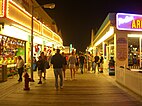Jenkinson's Boardwalk on Point Pleasant Beach | |
| Continent | North America |
|---|---|
| Region | Northeastern United States |
| Coordinates | 39°45′48″N 74°06′23″W / 39.7632°N 74.1064°W |
| Coastline | 141 mi (227 km) |
| Highest point | Mount Mitchill |
| Lowest point | Atlantic Ocean |
| Longest river | Raritan River |
| Largest lake | Manasquan Reservoir |
| Climate | Humid subtropical climate |
| Terrain | Atlantic Coastal Plain |
| Natural resources | Atlantic Ocean |
| Exclusive economic zone | Atlantic City |
The Jersey Shore, commonly referred to locally as simply the Shore, is the coastal region of the U.S. state of New Jersey. Geographically, the term encompasses about 141 miles (227 km)[1] of oceanfront bordering the Atlantic Ocean, from Perth Amboy in the north to Cape May Point in the south. The region includes Middlesex, Monmouth, Ocean, Atlantic, and Cape May counties, which are in the central and southern parts of the state.[2] Located in the center of the Northeast Megalopolis, the northern half of the shore region is part of the New York metro area, while the southern half of the shore region is part of the Philadelphia metro area. The Jersey Shore hosts the highest concentration of oceanside boardwalks in the United States.
Famous for its wide beaches, many boardwalks that include arcades, amusement parks, and water parks, the Jersey Shore is a popular vacation spot for residents of North Jersey, New York, Maryland, Delaware, Connecticut, and Pennsylvania. Certain shore communities are also popular with visitors of the Canadian province of Quebec. Due to New Jersey's peninsular geography, both sunrise and sunset are visible over water from different points on the Jersey Shore.
In 2012, Hurricane Sandy devastated much of the northern part of the Jersey Shore, spawning the demolition and rebuilding of entire neighborhoods, with reinvention on a physically and financially elevated, and economically upscale level; this process of gentrification escalated property values and transformed communities on the Jersey Shore into a second home for the New York financial community, akin to the more established Gold Coast and Hamptons on Long Island.[3]
- ^ "NJDEP | Division of Coastal Engineering".
- ^ Galant, Debra. "JERSEY; South Jersey Is Friendlier? Oh, Shut Up And Drive", The New York Times, April 9, 2000, accessed April 11, 2008. "For the purposes of dividing North Jersey from South Jersey, Gannett drew a line between Monmouth County and Ocean County. I decided that it would be amusing to drive down to this dividing line — which turned out to be the Manasquan River — and test the hypothesis."
- ^ Jill P. Capuzzo (June 16, 2017). "Not Your Mother's Jersey Shore". The New York Times. Retrieved September 17, 2017.
Five years after Hurricane Sandy destroyed communities along the shore, some towns have used the rebuilding process as a time to reinvent themselves.











